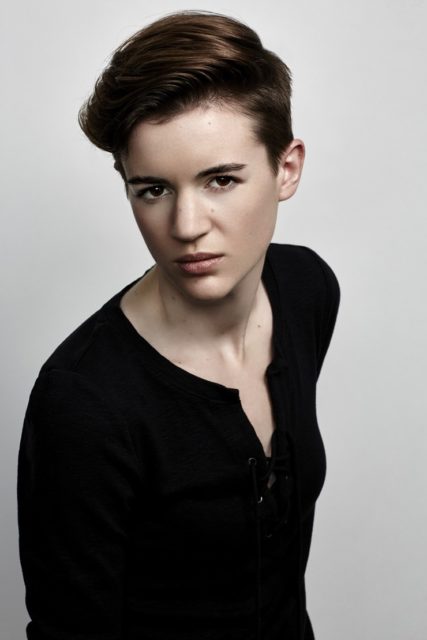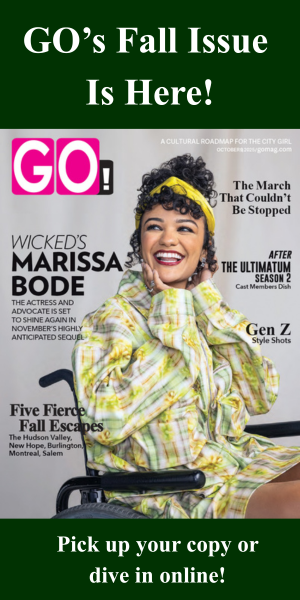Kyle McCoy on Bringing Genderqueerness to “America’s Next Top Model”

The out model shares some insight into her experience on the new season of one of television’s most queer-friendly reality shows.
“America’s Next Top Model” has consistently been one of the most queer-friendly reality competition shows, home to LGBTQ judges, designers and, of course, contestants. In the past, out women like Kim Stolz, Kayla Ferrel, Megan Morris, Elina Ivanova and “Empire” star AzMarie have competed on the series—all offering varied depictions of what queer women (read: models) look and act like in “real life.” After a brief hiatus in the wake of creator Tyra Banks’ stepping down, network Vh1 revamped the series with a new host, Rita Ora, but still maintained the show’s reputation for inclusiveness with a slate of queer contestants appearing on this season, including androgynous bartender Kyle McCoy.

A recent graduate of Rollins College, McCoy, the New York-based top model contender, was frequently compared to Ruby Rose by the judges’ panel, an often incorrect and lazy juxtaposition seemingly based on their shared non-binary aesthetic more than anything else. The formula of a show like “America’s Next Top Model” (at least in the current season) isn’t necessarily friendly to models like McCoy, who face some challenges that rarely translate to their more feminine-presenting peers.
“I do find it a little bit funny that my androgyny was something they were alleged to be celebrating about me at the beginning of the show and embracing and then they did kind of do everything in their power to repress it at times while also not really having the expectations of the other contestants to do what I do, or to embrace their masculinity in any real way,” McCoy said. “If they did happen to come out looking androgynous in certain photos, they would ‘ooh’ and ‘ahh’ at times, but it wasn’t something they were tested to do or forced to do. And yeah, at times it definitely felt like they might have been mocking me but I can’t say that’s 100 percent true or my own securities being projected.”
While on the show, Kyle was frequently femmed up more often than she was given the opportunity to fully embody the kind of model she really is—one more akin to the Erika Linders and Casey Leglers of the industry than the Gisele Bündchens. Yet, androgynous models like Linders and Leglers still play with feminine looks.
“People like Erika Linder who really can kind of do both sides of it—that was my goal when I first started working in the fashion industry, was to prove that gender really is a drag, like the old Judith Butler gender performativity thing,” McCoy said. “You go in your closet and you put your gender on every day. They are genuinely constructs, things that we came up with and made up and assigned to people and had no one told you what to wear, you might not have worn that dress or that suit.”
But this season of “Top Model” majorly focuses on portraying sexy choreography in faux music videos and exuding a high femininity that fails to extend to all areas of the modeling industry. McCoy acknowledges that fashion is, for her and many others, much more than that, and should embrace more of a playful element than a rigid one.
“I am someone who doesn’t identify entirely with one end of the gender spectrum,” Mccoy said. “I’ve always kind of touted a fluidity about myself that I’m pretty proud of, and on a day to day basis, I feel differently about who I am and how I feel—whatever. I don’t think I’m ever going to be the kind of person that embraces uber-femininity to the extent that maybe the fashion world or modeling industry would hope I would do. But in the same vein, I’m very hard pressed to be made uncomfortable by clothing because, again, I just don’t take it nearly as seriously as a lot of other people might in the sense that I see it as costume and drag, and it’s fun to dress up and it’s kind of fun to inhabit these different characters at times. But no, I didn’t let it cause me any kind of real gender identity crisis because, again, it’s clothes.”

What draws McCoy to modeling has more to do with her love of art, which she studied in school along with a concentration in classical poetry. She says that’s likely one reason why she’s such a “hopeless romantic,” a side to her we also caught a glimpse of on the show as she had a “showmance” with another contestant, Marissa.
“I just honestly can’t help myself sometimes,” McCoy said. “If I’m infatuated with someone, I’m very vocal about it. I don’t really have an off switch and I’m super, super shameless which probably comes from a childhood where I felt so ashamed of my feelings and sexuality that I finally got to a point where I was like, ‘You know what? Eff it. I’m going to be me; do me.’ And I’ve been pretty open-mouthed ever since, kind of doing what I do.”
McCoy was first let go from the show three weeks ago, but was brought back for Wednesday night’s episode with the rest of the eliminated models for one more shot at returning to the house. Although she enjoyed having some more time with Marissa, she said she was relieved to finally leave the show for good, as she found “being filmed 24/7 be a really overwhelming.” Although she’s done some modeling for friends in the industry since leaving the show, she’s not actively pursuing a career in fashion.
“When I graduated from college a year ago, I was recommended to take two years off and go out in the real world and get some experience—that’s what my poetry professor who was really my inspiration in college told me to do,” McCoy said. “And I’m slowly but surely coming up on the two years. The fact that ‘America’s Next Top Model’ took place for me in those two years, I don’t want it to either derail me or deter me from continuing on the path that I always was on.”

But on the plus side, being so visible on national television as a genderqueer person has afforded McCoy some attention from audiences she hoped for and anticipated.
“That was a major selling point for me in terms of why I overcame any type of fear to go on the show,” McCoy said. “I knew that there would be people out there who, one, hadn’t seen someone like me before and needed to see someone like me in order to realize we exist and that we are decent people. And that there would be people who look like me that had never seen themselves on television. I didn’t really see people like me on TV growing up so I knew if I represented myself well, it would be an inspiration for other people and that’s been overwhelmingly the feedback I’ve been getting.”
And of course, she’s also had some eager women sliding into her DMs.
“I get a lot of dates and drink offers on Instagram, none of which I really respond to,” McCoy said. “I’m flattered but at the same time, I know it’s really just about being a model or something. I keep a much lower profile than I used to and I’m not really out in the scene as much as I was prior to the show. Lesbians, we have our events and things like that but I haven’t been going to as many, sadly.”
McCoy is currently working on applying for grad school to get her MFA and says that despite the positives of appearing on “America’s Next Top Model,” she doesn’t have any more plans to return to television.
“I wouldn’t say no right off the bat,” McCoy said. “I just know it was a lot different from what I expected it to be.”
Follow Kyle on Instagram: @smile4kyle












